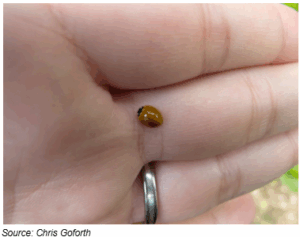Standards + Practices
DCI: LS2.A Interdependent relationships in ecosystems
CCC: Patterns
SP3: Planning and carrying out investigations
Students will be introduced to the overarching questions of the project and consider what data they can collect to address the questions. Students will learn about protocols for outdoor learning and collecting data to help them plan and carry out this investigation for the rest of the school year.
SP1: Asking questions and defining problems
Students will have opportunities to ask clarifying questions about the overarching questions of the project and features that help identify ladybugs.
SP8: Obtaining, evaluating, and communicating information
Students will use the Ladybugs at School data recording sheet to share data on the iNaturalist website about ladybugs they find on their school grounds.
Resources + Supports

Overarching Questions
This year, your students will serve as stewards of the ladybugs in their schoolyard to increase the number of ladybugs because the presence of ladybugs can indicate to us the environmental health of our school grounds. Students will contribute data to the Ladybugs at School project in iNaturalist and conduct searches to see how many ladybugs are present at this time, where they tend to be, and under what conditions. Using their findings from repeated searches of the school grounds, students will draw conclusions about the condition of the school environment. Students will get a sense of how ladybugs respond to changing conditions and what conditions are most suitable for ladybugs.
The data you collect in your schoolyard and comparisons you make in your data will help students explore these questions. We have provided support later in the year to address these questions, but it is helpful to discuss them with your students early on (and even post them in your classroom) so that they have them in mind as they participate in Ladybugs at School. As a class, make predictions about what students will find related to these two questions. These predictions will be revisited throughout the year as students come to understand more about ladybugs and the factors influencing their presence or absence in particular areas.
Note that how you collect your data may matter as you answer this question, i.e. if you have different numbers of students collecting at different times and in different locations on your school grounds every time you collect, it may impact your results. As you explore the overarching questions, it is useful to consider how you collected your data on any given day, as this will help you interpret your findings.
Frame your data collection as a means of answering two overarching scientific questions throughout the year:
1. How does the presence of ladybugs change across the school year? What might explain those changes?
a. Which species of ladybugs do we find at our school? Are they native, non-native, or both?
b. What features of our school grounds make the space habitable/uninhabitable for native ladybugs?
2. How can we improve the habitat for ladybugs in our schoolyard?

Ms. Jones Supports Data Collection and Recording
Ms. Jones’ students are experiencing success in finding ladybugs on their school grounds; however, she notices that students are having trouble completing the Ladybugs at School Data Recording form (PDF, editable form). Ms. Jones knows it will be problematic when later entering these data on the Ladybugs at School website and later on in the school year when they need to make sense of their data to respond to the overarching questions. Ms. Jones reminds students of the importance of consistently and accurately recording data so that it can be shared and used by others. She revisits each section of the recording sheet with students, reviewing the categories. Describing where searches have taken place has been challenging for students because they are not sure how specific to be in their descriptions. Ms. Jones suggests thinking about both abiotic and biotic factors as references using various playground structures and vegetation as reference points. As a class, they identify where the different types of vegetation (e.g., bushes/shrubs, woods/trees) can be found on their school grounds. She provides an example from their most recent search when students found one ladybug in their school garden and one on a shrub.
Ms. Jones also anticipates that after she introduces the Ladybugs at School field guide to her class, students will be overwhelmed by all of the different features used to identify ladybugs. Ms. Jones intentionally models how to think through ladybug identification by using a ladybug she photographed the previous week. She starts by focusing students’ attention on the thorax of the ladybug and noting the W shape on the thorax. Using the field guide, Ms. Jones points out that two ladybugs are known for having a W shape on their thorax: the Asian Multicolored Ladybug and 15-Spot Ladybug. To figure out which of the two her ladybug is, Ms. Jones refers to the descriptions on the field guide and notices that the sides of the thorax are white and that the ladybug is orange with 11 spots. Based on these observations, Ms. Jones concludes that the ladybug she found is an Asian Multicolored Ladybug. She points out to students that if she had only looked at the spots, it would have been easy for her to misidentify her ladybug because many ladybug species have a variable number and shape/size of spots, but combining this information with observations of a ladybug’s thorax is helpful for identification because of the unique characteristics of the thorax for each species.

Getting Started With Identifying Ladybugs
The following activities are great ways to engage student interest and motivation as they begin identifying ladybugs.
Name that Ladybug!
Show students the pictures of ladybugs and ask them to choose one to name. They can name them however they would like but need to provide reasoning for the name they choose. Have students share their names and reasoning.
Can you spot the difference?
Look at the pictures of ladybugs on the slides provided and try to find what is different about each image.
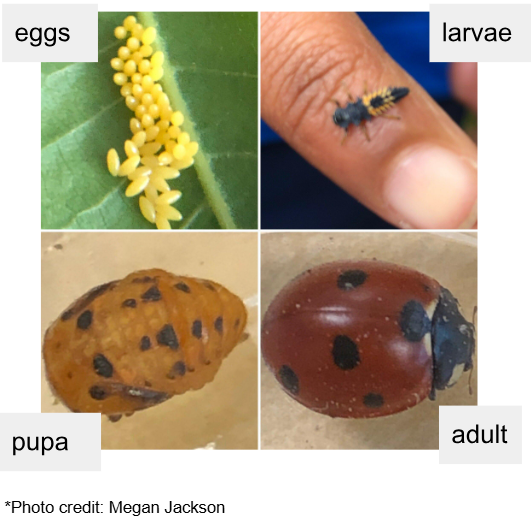
Anatomical Features
Start by asking students to think about the ladybug’s anatomical features they notice. Record student responses and classify them into categories (e.g. coloration, size, body shape, wings). Page 2 of the All About Ladybugs PDF resource explains the life cycle of a ladybug, and Page 3 explains the anatomy of a ladybug. This resource shows students that ladybugs are insects, and more specifically beetles.
If students have completed the Name That Ladybug! activity, look for connections between their reasoning for particular names and the anatomical features of ladybugs.

Ladybug Field Guide
To assist students in identifying the ladybugs they find, the following field guide has been created highlighting common ladybugs of North America: Common Ladybugs of US Field Guide. This document provides a picture, the common and scientific names, a brief description, as well as a label for exotic (non-native) and native species for each ladybug (If possible, it would be helpful to print color copies and laminate them for student use.). As students use this guide to identify the ladybugs they have found, have them pay particular attention to the color and design on the ladybug’s thorax and its overall color, rather than just counting the number of spots. It is much easier to identify a ladybug by the design on its thorax than the number of spots!
As this might be the first time a student is using a field guide, it is helpful to review each part of the guide. Use photographs taken to practice before using live specimens.

In this activity, students will use the field guide and photographs of ladybugs to identify the species they are and generate questions regarding the species. Consider using pictures from the earlier activities Can You Spot the Difference? and/or Name That Ladybug! to inspire students to generate questions:
- What do I notice and wonder about this ladybug?
- Am I identifying the correct species?
- What more can I find out about the ladybug?
Focus on how students are using the field guides and photographs to assist them in identifying the ladybugs this month.

Native and Non-Native species
The field guide lists ladybugs as native or exotic (non-native) in North America (see picture below).
Native species: species that normally live and thrive in a given region.
Non-native species: species that do not naturally occur in an area and are introduced accidentally or purposefully.
You may see the terms “non-native” and “exotic” used interchangeably and these are viewed as neutral terms by those in the field. In contrast, the term “invasive,” carries a negative connotation. There are conflicting views as to whether non-native species should be considered invasive.

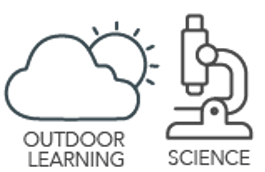
Getting Started With Data Collection
This video provides an overview of how to report data in iNaturalist.
Tips for Photographing Ladybugs
Finding and photographing ladybugs will require some effort to accomplish but will be key to participation in the Ladybugs at School project. In addition, treat ladybugs with care, as they are living specimens.
To ensure high-quality data collection throughout the project, while maintaining ethical considerations of live specimens, review the following prior to finding and photographing ladybugs with your students.
- What devices will your class use to photograph ladybugs? Do you have a class set of cameras? iPads? An iPhone? Will you use a clip-on magnifying lens (such as a macro lens) to take an up-close photograph? Do your students know how to use the device to take a photograph?
- Ladybugs can either be photographed where found or collected to be photographed later. Photographing them on the leaf or ground where you have found them is safer for the ladybug, yet harder for the photographer. Consider what your class protocol will be for photographing and recording once a ladybug is found. For example, will you collect it in a container to photograph at a later point, or will your students take a photograph right when it is located?
- Unless collecting them to photograph later, try to avoid having students handle ladybugs.
- What tools are needed for your students to carefully and safely collect ladybugs to photograph at a later point? Do you have containers with lids to keep them in? It will be important for you to demonstrate how to safely put a ladybug into the container. Once there, where will you place the container so the ladybugs do not die? Do you have a cooler or refrigerator to keep them in until you are ready to photograph them? (Note: It is recommended that ladybugs are kept in a cooler or refrigerator no longer than a few days; in a freezer, no more than 5 minutes.) Once you have finished collecting, what will be your protocols for photographing and releasing them back where students found them?
- Photographing them in the location you’ve found them is perfectly acceptable (although slightly more difficult) and safer for the ladybugs. Attempt to get as close as possible to the ladybug with your lens, rather than your hand, to try to capture a shot before it flies away. Also consider what device students will be using, and how will they record data about that photograph? It might be helpful to organize your photos by creating a folder on your desktop organized by date and habitat (location) where they were found. If using a camera, you can record the photo number on your data recording sheet to keep track of the photographs.
|
On Apple devices, you can change settings to save all photographs in jpeg format, which is compatible with iNaturalist. Settings > Camera > Formats > Check “Most Compatible” |
- Will each student, or small group, have a data recording sheet to keep track of the ladybugs as they are found and where they are found, or will you have one student recording information for the whole class?
- Will you enter the data immediately while outdoors, upon return to the classroom, or at a later time? It will be easy to forget to enter the data after time exploring outdoors. Be sure to have routines in place to enter the data on the website so it does not pile up.
This project involves a lot of outdoor fieldwork. Therefore, consider the following list of Outdoor Protocols prior to going outside with your class. For example, specific guidelines should be established about how far a student can “follow” a ladybug. If they fly away, the ladybugs will move faster and farther than expected. Be sure to reassure students that it will be okay if they miss it or are unable to “follow” it.
Tips for Collecting Ladybugs
Tips on collecting ladybugs to hook students into Ladybugs at School:
- Consider finding ladybugs at home, at a park, or on your school grounds. Use a sweep net in a meadow or field, look in bushes or flowers, or under leaves on trees.
- Keep ladybugs in a clear, closed container with small, pin-sized holes for breathing. Ladybugs can be kept cool in a cooler or refrigerator, but should not be left there for more than a few days.
Purchasing ladybugs from Scientific Supply companies could have negative environmental implications. If you have considered purchasing ladybugs for your classroom, please reflect on the following prior to purchasing:
- Research where the vendor gets their supply. Are the ladybugs native to your area? If exotic species are released, native species will be forced to compete for habitat and food.
- Ladybugs that are purchased through vendors may be vacuumed up from the wild in California during the winter and transported across the country to be delivered. These ladybugs may be genetically distinct from the individuals of the same species in your area, and the two populations may not typically interact without human intervention.
If your class is unsuccessful finding ladybugs during your searches, review the suggestions in the “Not Finding Ladybugs” blue boxes in each month’s supports.
Sightings Outside of School
What about when students see ladybugs at home or outside of school time? The following list provides questions to consider:
- Will you encourage safe participation outside of school? Do all of your students have access to areas where ladybugs might be found outside of school time?
- If yes, remind students to ask for permission from their guardians first and to search in locations where they feel safe.
- If no, explain to students why you would prefer they not participate outside of school.
- Will students bring the ladybugs into school to record the data or will they record the data at home?
- If bringing into school:
- Do students have proper collection containers?
- Do students know how to handle ladybugs carefully?
- If recording data at home:
- Do students know all of the information needed for submission on the iNaturalist website? Will you provide students with data collection sheets?
- Will students upload the information themselves onto the website (and if so, do they have your login information) or wait to upload once they get to school?
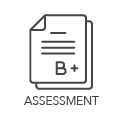
Ladybug Identification
Ladybug Identification Quiz
Use the following quiz (Powerpoint, PDF) to assess students’ identification skills.
Ladybug Exit Ticket
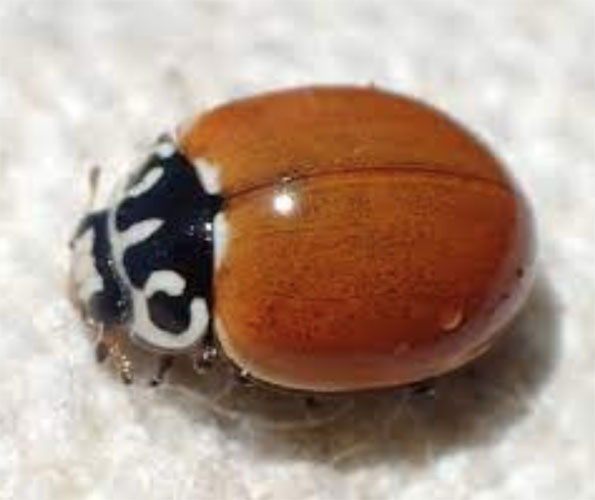
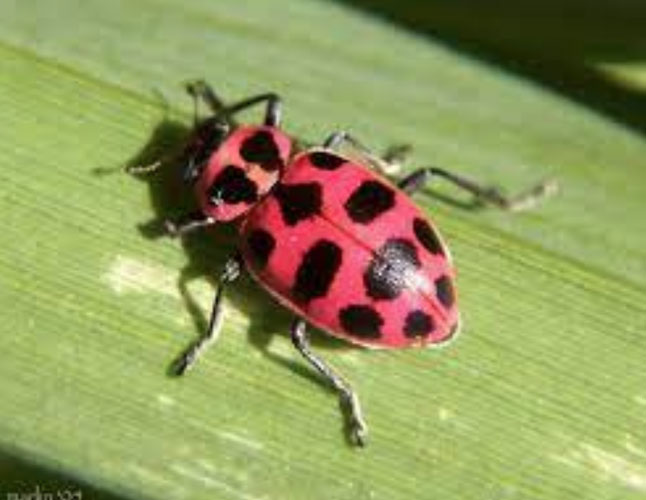

|
1a. Look at ALL of the ladybugs above. What are TWO features that could help you identify the ladybugs?
|
1b. Explain how the features you listed in part (a) could help you identify the ladybugs. |
|
2. Draw a ladybug in the space provided below and label its major parts.
|
|
Teacher Note: Pay particular attention to how students respond to both parts of question 1. Identifying ladybugs is a large part of their work with Ladybugs at School. If students struggle to identify features that can be used for identification and explain how they are used to make identifications, consider using one ladybug picture to model the process a person would go through to identify it using a field guide. While modeling, have students record the features used and compare them with the field guide pictures. If students identify the ladybugs instead of explaining how they used ladybug features to make an identification, encourage students to go back and explain their process. In addition, be sure students are focused on the ladybug anatomy in their response to question 2.

In next month’s activities, students will continue collecting, photographing, and identifying ladybugs. Students will also begin mapping their data, which will allow students to start thinking about habitat features and conditions that are suitable for ladybugs. Try showing students an aerial view of your school or another area to help prepare students for using an aerial view to map their data.


